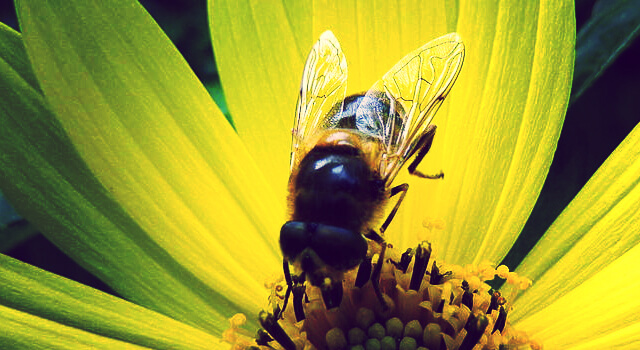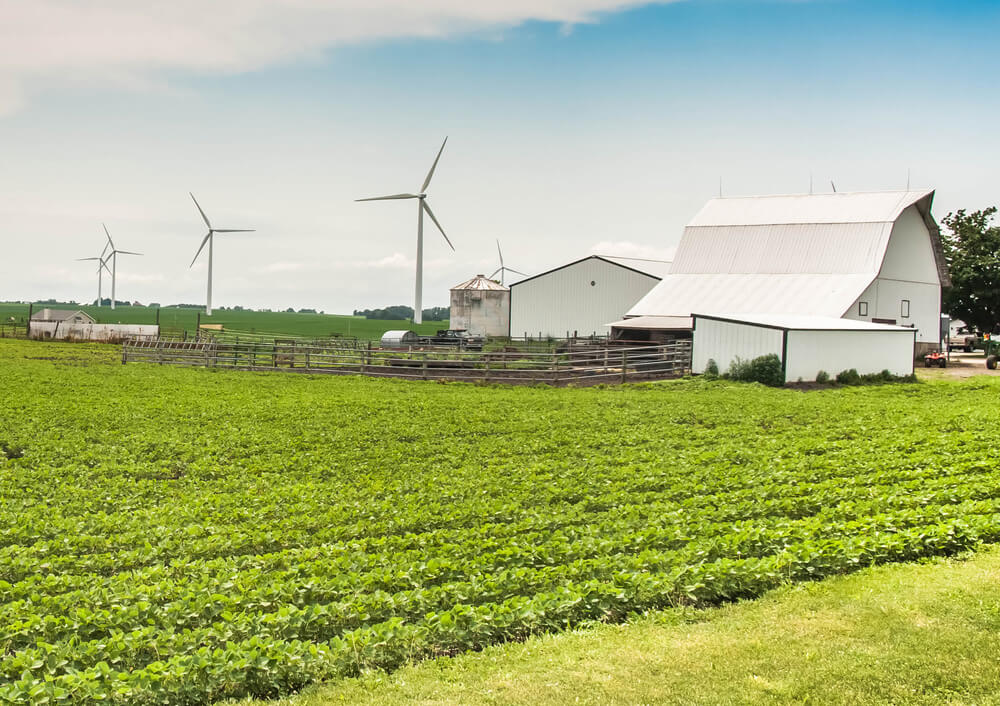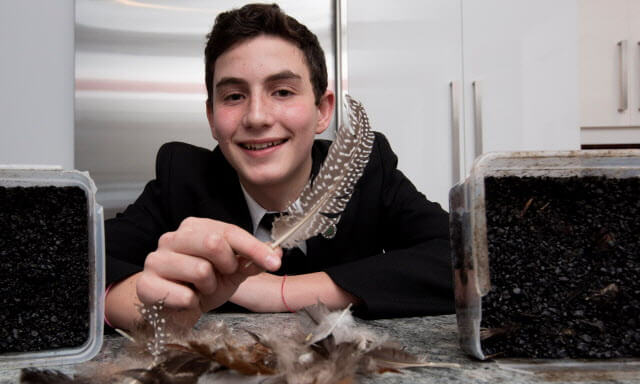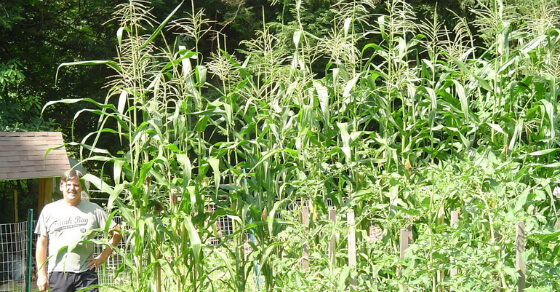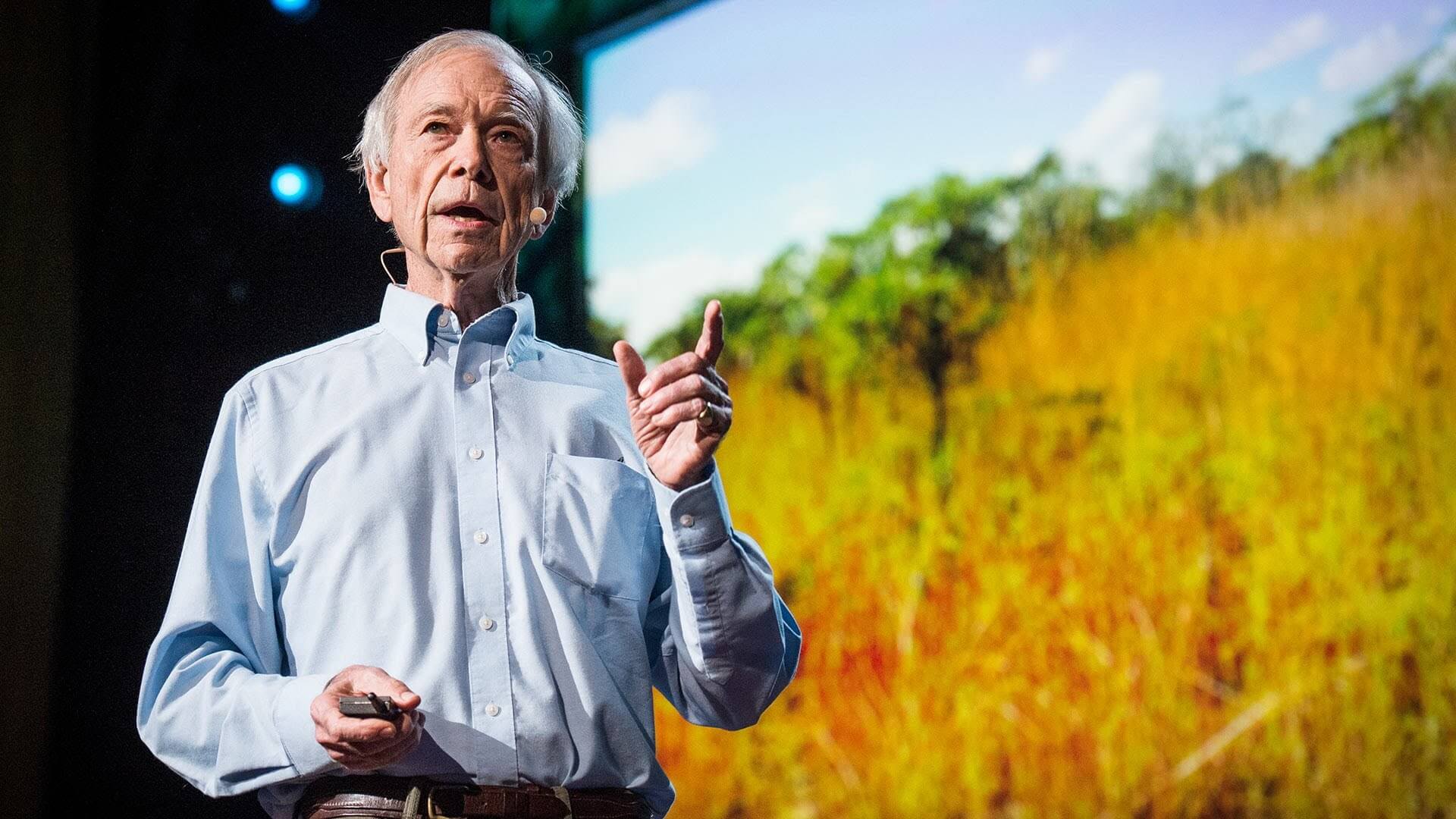Microbes Will Feed the World, or Why Real Farmers Grow Soil, Not Crops – Modern Farmer

Out on the horizon of agriculture’s future, an army 40,000 strong is marching towards a shimmering goal. They see the potential for a global food system where pesticides, herbicides and fertilizers are but relics of a faded age.
They are not farmers, but they are working in the name of farmers everywhere. Under their white lab coats their hearts beat with a mission to unlock the secrets of the soil – making the work of farmers a little lighter, increasing the productivity of every field and reducing the costly inputs that stretch farmers’ profits as thin as a wire.
‘Producing more food with fewer resources may seem too good to be true, but the world’s farmers have trillions of potential partners that can help achieve that ambitious goal. Those partners are microbes.’
The American Society of Microbiologists (ASM) recently released a treasure trove of their latest research and is eager to get it into the hands of farmers. Acknowledging that farmers will need to produce 70 to 100 percent more food to feed the projected 9 billion humans that will inhabit the earth by 2050, they remain refreshingly optimistic in their work. The introduction to their latest report states:
“Producing more food with fewer resources may seem too good to be true, but the world’s farmers have trillions of potential partners that can help achieve that ambitious goal. Those partners are microbes.”
Mingling with Microbes
Linda Kinkel of the University of Minnesota’s Department of Plant Pathology was one of the delegates at ASM’s colloquium in December 2012, where innovators from science, agribusiness and the USDA spent two days sharing their research and discussing solutions to the most pressing problems in agriculture.
“We understand only a fraction of what microbes do to aid in plant growth,” she says. “But the technical capacity to categorize the vast unknown community [of microorganisms] has improved rapidly in the last couple of years.”
Microbiologists have thoroughly documented instances where bacteria, fungi, nematodes – even viruses – have formed mutually beneficial associations with food plants, improving their ability to absorb nutrients and resist drought, disease and pests. Microbes can enable plants to better tolerate extreme temperature fluctuations, saline soils and other challenges of a changing climate. There is even evidence that microbes contribute to the finely-tuned flavors of top-quality produce, a phenomenon observed in strawberries in particular.
“But we’re only at the tip of the iceberg,” says Kinkel.
In the Field
Statements such as, “There are 10 to the 6th fungal organisms in a gram of soil!” and, “This bacterial biofilm has tremendous communication properties!” are breakroom banter among microbiologists, but what does it all mean for farmers? The answers reach back into the millennial past of agriculture, back to the dawn of life on earth.
Whenever a seed germinates in the wild or a crop is planted by a farmer, the microbial community that helps that species to grow and thrive is mobilized. Chemical signals enter the soil via the exudates of the plant and a symphony of underground activity commences. Genetic information is exchanged; the various microbial players assume their positions on the tissues of the plant; often, one microbe colonizes another, providing a service that helps the first microbe to assist the plant whose roots it is embedded in.
Though this elaborate dance takes place without any input from humans, we have been tinkering with it for a long time.
For example, the process of nitrogen fixation in plants of the legume family (which includes beans, peas, peanuts and many other crop plants) is one of the little bacterial miracles that makes our planet habitable. Anyone who has ever observed the roots of a legume knows that they are covered in strange white or pinkish growths, about the size of ants, which appear to be an infection of some sort. Undoubtedly, ancient farmers had an intuitive understanding that these warty protuberances had something to do with the noticeable ability of legumes to improve the soil, but it wasn’t until the late 19th century that the mystery began to unfold.
While Louis Pasteur was discovering how to preserve milk and becoming famous as the father of microbiology, a relatively unknown colleague of his with a penchant for plants was making another discovery, of perhaps even greater historical importance. In 1888, Martinus Beijerinck, discovered that tiny bacteria called Rhizobia infect the roots of legumes, causing the swollen nodules. Rather than an infection that weakens the plant, the nodules are the fertilizer factories of the plant kingdom, disassembling atmospheric nitrogen – which plants are unable to use – and refashioning it in a soluble, plant-friendly form.
Rhizobia are key ingredients of the earth’s verdancy and harnessing the bacteria to improve soil fertility has long been one of the cornerstones of sustainable agriculture. Yet, modern day microbiologists are now aware of scores of other equally profound plant-microbe interactions, discoveries they believe will have a big impact as human populations continue to soar on a planet of finite resources.
Making the Translation
In her lab at the university, Kinkel experiments with antibiotic bacteria that suppress plant pathogens and tests various soil management strategies to see their effects on microbial communities. In Colombia, microbiologists have learned to propagate a fungus that colonizes cassava plants and increases yields up to 20 percent. Its hyphae – the tiny tentacles of fungi – extend far beyond the roots of the cassava to unlock phosphorus, nitrogen and sulfur in the soil and siphon it back to their host, like an IV of liquid fertilizer.
In Colombia, microbiologists have learned to propagate a fungus that colonizes cassava plants and increases yields up to 20 percent
Though microbiologists can coerce soil to produce extraordinary plant growth in their labs and test plots, transferring the results to everyday agricultural practices is not a straightforward process.
“Connections to farmers are a weak link,” Kinkel laments, alluding to a “snake oil effect” where farmers have become leery of salesmen hawking microbial growth enhancers that don’t pan out in the field. “The challenge of [these] inoculants,” she says, “is they may not translate in all environments.”
Though researchers continue to develop promising new microbial cocktails, there is an increased focus on guiding farmers to better steward the populations that already exist in their soil. Kinkel is working on an approach she believes will help farmers sustain optimal microbial communities by ensuring they have the food they need – carbon – at all times. She calls it ‘slow release carbon’, but it’s not something farmers will see in supply catalogs anytime soon. Kinkel says she has access to resources for her academic research, but lacks a “deliberate pipeline for product development.”
It Takes a Global Village
The 26 experts from around the world convened at the ASM colloquium concluded their discussions with a bold goal for the future of agriculture: They’ve challenged themselves to bring about a 20 percent increase in global food production and a 20 percent decrease in fertilizer and pesticide use over the next 20 years.
With an indomitable belief that science will do its part to make this dream a reality, the scientists are looking to their corporate and regulatory counterparts to build a pipeline of information to farmers. They’re hoping that top-down investments in research and technology will meet directly with grassroots changes in the culture of farming – without all the snake oil-vending agribusiness interests in the middle. Ultimately, they envision a future where farmers again trust in the unseen forces of the soil – instead of the fertilizer shed – for answers to their challenges.
Monsanto Loses GMO Permit In Mexico – Judge Sides With The Bees
A number of countries around the world have now completely banned GM food and the pesticides that go with them, or have severe restrictions against them. This comes after the world has experienced a massive resistance against Monsanto and other biotech giants that manufacture GMOs and pesticides.
It’s (the resistance) also a result of numerous studies that have emerged showing the environmental and health dangers that are associated with pesticides, as well as health dangers that could be associated with GMOs.
The latest country to make headlines with regards to banning Monsanto products is Mexico, as a group of beekeepers was successful in stopping Monsanto from the planting of soybeans that are genetically modified to resist their Round-up herbicide.
Monsanto Loses Mexican Permit
Monsanto had received a permit to plant its seeds on over 250,000 hectares of land, which equates to approximately 620,000 acres. That’s a lot of land, and they managed to get the permit despite thousands of citizens, beekeepers, Greenpeace, Mayan farmers, The National Institute of Ecology and other major environmental groups protesting against it.
According to The Guardian:
“A district judge in the state of Yucatán last month overturned a permit issued to Monsanto by Mexico’s agriculture ministry, Sagarpa, and environmental protection agency, Semarnat, in June 2012 that allowed commercial planting of Round-up ready Soybeans. In withdrawing the permit, the judge was convinced by the scientific evidence presented about the threats posed by GM soy crops to honey production in the Yucatán peninsula, which includes Campeche, Quintana Roo and Yucatán states. Co-existence between honey production and GM soybeans is not possible, the judge ruled.” (source)
Mexico is the fourth largest honey producer and fifth largest honey exporter in the world.
These Pesticides Are Killing Bees and Farmers Are Unable To Export Pollen From GMO Crops
Be colonies are declining very fast, threatening food security all over the world, and as the guardian reports:
“GM crops could devastate the important European export market for Mexican beekeepers, where the sale of honey containing pollen derived from GM crops has been restricted since a landmark decision in 2001 by the European Court of Justice.”(source)
Here is more on a study that found GM pollen destined for Europe after this ruling, and according to local farmers, threatens the honey industry.
Below is a summary of the problem (apart from massive bee declines):
“David Roubik, senior staff scientist at the Smithsonian Tropical Research Institute, and his colleagues developed the ability to identify pollen grains in honey in Panama and in Mexico during the 1980s and 1990s when they studied the effects of the arrival of Africanized bees on native bees. “Nobody else can do this kind of work in the ‘big field’ environment and be confident that what they are seeing are soybean pollen grains,” said Roubik. They found that six honey samples from nine hives in the Campeche region contained soy pollen in addition to pollen from many wild plant species. The pollen came from crops near the bee colonies in several small apiaries. Due to strict European regulations, rural farmers in the Mexican Yucatan face significant price cuts or outright rejection of their honey when their product contains pollen from GMO crops that are not for human consumption. The regional agricultural authorities, furthermore, seemed unaware that bees visited flowering soybeans to collect nectar and pollen” (source)
Related CE Articles with links to more information and proof:
New Harvard Study Proves Why All The Bees Are Dying American Scientists Confirm: Pesticides Are Killing Bees It’s Not Just Bees, Disappearance of Monarch Butterflies Also Linked To Roundup Herbicide EPA Approved GMO Insecticide Responsible For off Millions of Bees & Puts Entire Food Chain At Risk
There Are Multiple Concerns Here, And One of Them Has To Do With The Crops That Have Been Genetically Manipulated To Resist Monsanto Pesticides. Why? Because These Pesticides Are Very Harmful To Human And Animal Health.
A study is published in the US National Library of Medicine and in the journal Food and Chemical Toxicology shows how several recent studies illustrate glyphosate’s potential to be an endocrine disruptor. Endocrine disruptors are chemicals that can interfere with the hormone system in mammals. These disruptors can cause developmental disorders, birth defects and cancer tumors. (source)
A group of scientists put together a comprehensive review of existing data that shows how European regulators have known that Monsanto’s glyphosate causes a number of birth malformations since at least 2002. Regulators misled the public about glyphosate’s safety, and in Germany the Federal Office for Consumer Protection and Food Safety told the European Commission that there was no evidence to suggest that glyphosate causes birth defects. (source)
A new study out of Germany concludes that Glyphosate residue could reach humans and animals through feed and can be excreted in urine. It outlines how presence of glyphosate in urine and its accumulation in animal tissues is alarming even at low concentrations. (source)
It’s also been linked to Alzheimers, Parkinsons Disease and Autism.
A recent study conducted by researchers from RMIT university, published in the journal Environmental Research found that an organic diet for just one week significantly reduced pesticide (commonly used in conventional food production) exposure in adults. ( source)
Thirteen participants were randomly selected to consume a diet consisting of at least 80% organic or conventional food for precisely 7 days, afterwards crossing over to the alternative diet from which they started. Urinary levels were used for analysis. The study found that urinary dialkylphosphates (DAPs) measurements were 89% lower when they ate an organic diet for seven days compared to a conventional diet for the same amount of time.
“A lot of these agents were initially developed as nerve gases for chemical warfare, so we do know that they have toxic effects on the nervous system at high doses. Conventional food production commonly uses organophosphate pesticides, which are neurotoxins that act on the nervous system of humans by blocking an important enzyme. Recent studies have raised concerns for health effects of these chemicals even at relatively low levels. This study is an important first step in expanding our understanding about the impact of an organic diet” (source) – Dr. Liza Oates
Here is a link to more information on how the Roundup herbicide was recently found to be 125 times more toxic than regulators claim.
The list goes on and on, but bottom line is that there is a tremendous amount of evidence, and it’s great to see countries like Mexico take more steps towards a completely GMO/Pesticide free environment.
For more CE articles on pesticides click HERE. For more CE articles on GMOs click HERE.
Like this article? Then join the Conversation with many others in EWAO !
Sources:
http://phys.org/news/2014-02-gmo-soybean-pollen-threatens-mexican.html http://www.theguardian.com/global-development/poverty-matters/2014/aug/08/sweet-victory-beekeepers-monsanto-gm-soybeans All other sources are embedded throughout the article.
Credit: Collective Evolution
WHAT ARE YOUR THOUGHTS?
The Plan to Mop Up the World’s Largest Oil Spill With Fungus
The dinner plate-sized mushroom encircles its host tree like a bloated tumor. I’m about to snap a photo of the beast when something flickers in the corner of my eye. Faint, smoky wisps give off the impression of smoldering coals. At this very instant, the fungus is releasing billions of microscopic spores.
I feel as though I’m witnessing one of nature’s secret acts, something an urbanite like me was only supposed to see on National Geographic. With a lush green canopy overhead, the hum of insects and warbles of tropical birds filling my ears, the moment would be Avatar-worthy, save one jarring detail: The air reeks of petroleum.
That’s because I’m standing over a patch of blackened, crude-soaked ground. I’m here in the Sucumbíos province of northeast Ecuador with Donald Moncayo, a community organizer with the Amazon Defense Coalition. This spot, Moncayo says, holds a special significance. It’s the first in a series of nearly a thousand toxic waste pits that litter this remote part of the Ecuadorian Amazon, festering like open sores under the fierce equatorial sun.
“All the pools are in direct contact with the water and the soil,” said Moncayo, who has been taking visitors on his so-called ‘toxic tours’ since the early 2000s. “There are no membranes, no barriers, nothing. All of this was intentional.”
These toxic waste pools-locals call them ‘piscinas’-are the legacy of Texaco’s twenty six-year stint extracting oil from Sucumbíos. (Texaco has since become a subsidiary of Chevron.) The spills have been poisoning the soil, water, vegetation and people of the region for over twenty years.
Credit: Amazon Mycorenewal Project
Not ten meters away, one of the most amazing mushrooms I’d ever laid eyes on-and, after years as a microbial ecologist, I’ve seen my fair share-is breathing new life into the forest. To me there’s something serendipitous about this, because I’ve traveled to Sucumbíos to meet a group of scientists and activists who hold the radical notion that fungi are the key to empowering the victims of a horrific environmental disaster to clean up their land.
“Oil companies don’t teach people the solutions to their problems, because that would be an admission of their own wrongdoing.” Lexie Gropper, the program coordinator for the Sucumbíos Alliance of Bioremediation and Sustainability (ABSS), told me. “They prefer people who lack the power to make a change.”
But Gropper believes that change is coming. In less than a year, the exuberant, Spanish-speaking 24-year-old from Atlanta, Georgia has rolled together enough local and international resources to lay the groundwork for an organization dedicated to improving the health of humans and the soiled Amazonian environment through fungi. A collaboration between the US-nonprofit the Amazon Mycorenewal Project, and the Instituto Superior Tecnológico Crecermas (ISTEC), Sucumbíos’s only higher education institute, ABSS aspires, over the coming years, to transform a humble agricultural university into Ecuador’s primary hub for mushroom cultivation, distribution, and education.
The project’s aim? Nothing short of cleaning up the one of the world’s largest oil disasters -using giant, petroleum-gobbling fungi.
Credit: Amazon Mycorenewal Project
There are an estimated 1.5 to 5 million species of fungi: Yeasts and molds along with mushroom-producing macrofungi. It’s a clan of bizarre creatures that spend most of their lives unseen, sweating out a plethora of digestive enzymes that decompose the dead and recycle elements for the living. Some fungi use threadlike mycelia to worm their way into the soil’s smallest cracks and crevices, unlocking nutrients which they trade plants for carbon. When crusading mycologist Paul Stamets waxes poetic about fungi, he calls them “the neurological network of nature,” for their ability to knit together the lives of plants, animals, and the Earth itself. He’s right.
When it comes to mopping up our nastiest environmental messes, fungi may be one of the best hopes we’ve got. Certain species, including the oyster mushroom, produce enzymes that break down the tough, aromatic hydrocarbons found in petroleum, in addition to soaking up heavy metals like mercury. Deep in the Amazon, scientists uncovered a fungus that eats polyurethane plastic. Stamets, meanwhile, is involved in an effort to clean up the nuclear wasteland around Japan’s Fukushima reactor using radiation-loving mushrooms. And these are just the highlights; most experts will agree that we’ve barely scratched the surface of Kingdom Fungi’s potential.
“At this point, there’s simply no concept of how many fungal remediators are out there,” said Tradd Cotter, whose South Carolina-based company, Mushroom Mountain, is positioned to become the world’s largest hub for mycoremediation-the process of using fungi to clean up the environment. “All fungi can exude extracellular metabolites.” (Those are the enzymes, antibiotics, and other biological factors that actually do the remediation.) “When you consider 1.5 million fungi on the planet, all you can say is there are an unlimited number of possibilities.”
And there few places on Earth that match Sucumbíos’s desperate need for environmental remediation. According to Amazon Watch, from 1964 to 1990, the oil company Texaco (now Chevron) drilled 350 petroleum wells across a massive swath of previously untouched wilderness, all the while dumping some 18 billion gallons of toxic formation waters (a byproduct of oil extraction) directly into rivers and streams that the region’s tens of thousands of indigenous Ecuadorians depended on for drinking, cooking, bathing, and fishing. When Texaco left in 1992, it poured the rest of its waste-crude and toxic sludge-into the unlined death pits I found myself wading through.
Credit: Lexie Gropper
If people outside of South America know anything about northeastern Ecuador’s politics, it’s likely of the multibillion-dollar class action lawsuit that ensued after Chevron proclaimed it would not compensate the local victims exposed to the toxic blight, and would instead ” fight until hell freezes over.”
For over two decades, the oil giant has done just that, spending billions of dollars on thousands of lawyers to deny and delay legal proceedings. When I contacted Chevron for comment, a company spokesperson denied the existence of the toxic waste pits, claiming they were part of a “decade long disinformation campaign in support of judicial fraud in Ecuador by plaintiff’s lawyers trying to extort money from Chevron.”
This stance speaks to Chevron’s recent counteroffensive in the legal battle, the basis of which is to paint the plaintiffs-30,000 homesteading farmers and tribespeople-as a group of scheming mafiosos.
“Chevron’s strategy has been total-scorched-Earth,” Kevin Koenig of Amazon Watch told me. “They subpoena people, they drag them into court, they scare the living shit out of them. And they have all the time and money in the world.”
The same cannot be said for the thousands of men, women and children who, every day, are forced to drink water fit for a hazardous waste facility. These include the family of Marlene Cabrera, who lives next to an oil well outside the sprawling oil-boomtown of Lago Agrio. When we visited, Cabrera recalled how she never used to salt her food, because the river water she cooked with was brackish from toxic waste. Her sixteen-year-old son has been ill with a rare disease, which doctors believe is related to oil contamination, since he was nine. She has seen several family members, with no history of drinking or smoking to excess, die young of cancer. Countless families throughout the province echo her story.
As the beleaguered legal battle moves into its twenty-second year, indigenous communities, aided by a handful of dedicated international groups, have begun taking matters into their own hands. The most prominent example is ClearWater, an organization whose mission is right in its name. In 2011, co-founder Mitch Anderson organized a team comprised of men and women from the region’s five indigenous tribes. Thanks to a major grant from Trudie Styler’s Rainforest Fund and other celebrity contributions, ClearWater has furnished over a thousand indigenous families with sophisticated rainwater catchment systems that remove bacteria while soaking up heavy metals and petroleum hydrocarbons.
“ClearWater is about provisioning the basic necessities of life to the people who have called these forests home for thousands of years,” Anderson said when I called him from Quito.
Credit: Amazon Mycorenewal Project
Gropper, who assumed the project coordinator role for the Amazon Mycorenewal Project in early 2014, tells me how ClearWater’s grassroots, community-oriented vision has been a source of inspiration. Founded in 2007 by an international cohort of bioremediators, mycologists and environmental scientists, the Amazon Mycorenewal Project has, over the years, generated excitement by demonstrating the potential for fungi to detoxify the putrid soils and rivers of Sucumbíos. But until very recently, the organization lacked the local infrastructure needed to conduct long-term studies and create a lasting impact.
“As international volunteers, we come and we leave,” said Gropper. “We like to tell locals how they can fix their problems, without really thinking about their needs. But until we’ve shown that we can make this work for the people of Sucumbíos, we haven’t accomplished anything.”
Through its integration with ISTEC, Gropper believes the Amazon Mycorenewal Project is now positioned to build permanent ties with the local communities.
“Our alliance with an Ecuadorian agriculture institute provides so many opportunities to grow,” Gropper said. “It’s everything the Amazon Mycorenewal Project ever dreamed of.”
For its part, ISTEC has made it clear that their new, fungally-minded partners are a priority. The university has furnished the fledgling organization with on-campus housing, in addition to five laboratories to be used for soil and water testing, microbiology, mushroom cultivation, and eventually, large-scale spawn production. When I visited, international volunteers were hard at work converting the empty labs into sophisticated research facilities. They’re also teaching themselves mushroom cultivation techniques and conducting the first pilot studies that, eventually, will lead to a library of petrophilic fungi-those with a knack for growing on toxic waste.
When Norwegian volunteer Gudny Flatabø arranged a series of Petri dishes on the lab bench, several were an inky black, instead of the usual tawny hue. Mycelia-the branching, filamentous part of fungi that colonize vast surfaces-gobbled the contaminated agar, unperturbed by the toxicity of their food. Over time fungi that tolerate the spectrum of toxins found in petroleum waste-benzene, toluene, chromium and mercury, to name but a few-can be bred to handle higher and higher concentrations.
Credit: Amazon Mycorenewal Project
“You need to do this basic science first, prove that it works, prove why it works,” Cotter, who is also overseeing mycoremediation projects in Haiti and the Alberta tar sands, in addition to advising the Ecuadorian initiative, told me.
According to Cotter, there are a hundred things to test and tweak before a fungal remediator is ready for prime time, including physical properties like its tensile strength and ecological properties, including how the fungus interacts with and shapes the native microbial community.There’s also the matter of finding local remediators-fungi that grow naturally near the disaster site. Once their sterile cultivation facilities are ready, Gropper plans to isolate native fungi that already thrive in local contaminated sites.
“We want to figure out what the best local remediators are and what are the best conditions to grow them,” said Gropper. “Then we can scale up production, and create a spawn distribution system that’s sustainable long after volunteers are gone.”
Large-scale fungal remediation is a long-term goal, and Gropper is cognizant that locals will need strong incentives to buy in. She is hopeful that, through cultivation workshops and classes, her organization will get Ecuadorians excited about the myriad possibilities mushrooms offer.
“I think nutritional and medicinal aspects of mushrooms are what’s really going to get people interested,” Gropper told me.
The nutritious turkey tail mushroom, for instance, helps our immune system fight off cancer. The reishi mushroom, which grows naturally in Sucumbíos, has well-documented antibacterial properties.
“They’ve lived with the contamination for over forty years,” Gropper continued. “They’re not happy about it, but they’re used to it.”
That fact was sadly clear by the end of my toxic tour. In addition to visiting gaping waste pools and drilling sites, Moncayo brought us to see a “remediated” pit. Chevron claims that Texaco conducted a successful remediation of 162 pits in the mid-1990’s. Others call this cleanup a sham. It only took a few inches of digging in the blistering jungle heat for Moncayo, wearing white surgical gloves, to unearth a fistful of tar-colored mud. He dropped a chunk of the stuff in a water bottle, shook it up, and we looked on as oily crude floated to the surface, gleaming blue and orange in the sunlight.
Not far off, a cacao tree was laden with nearly-ripe pods. Moncayo pointed to it. “Cacao grown here, grown across contaminated sites, is taken to markets in Lago,” he said. “It’s mixed with cacao from all over Ecuador. It’s exported to the United States, Canada, Europe-everywhere.”
Also close by, two local men were laboring to dig a new well under the searing mid-afternoon sun. The well, Moncayo said, would probably be used for drinking water.
Credit: Amazon Mycorenewal Project
As I stood, dizzy from dehydration and petroleum fumes, next to the last toxic sludge pool of the day, Moncayo told me how everything I’d seen was but a drop in the bucket. “When we talk about thirty thousand people affected, we’re only talking about those right next door to a drill site,” he said. “When we consider those indirectly affected, we’re talking about the entire population of Brazil. That’s where this water goes.”
It’s an almost inconceivably vast problem. But the people I found living here haven’t given up on this land. Gropper, for one, sees mushroom cultivation taking off all over Sucumbíos and beyond, providing the Amazon and its people with a host of benefits. Just maybe, a myco-topia isn’t so crazy, after all.
“Justice isn’t something that the government has in its pocket or Chevron has in its bank account,” Anderson said. “It’s something that communities build.”
Koenig agrees. “What’s amazing about the grassroots efforts we’re now seeing is that they’re turning people who have always been victims into a force and a solution.”
The fungi, for their part, aren’t going anywhere. They’ll continue to creep and grow, dancing in and out of sight, threading hungry mycelia into the fetid soil. Earth’s decomposers will remain here, long after people have decided whether or not to forsake the poisoned land. Perhaps, with their help, we won’t have to.
Credit: Nicola Peel and Danny Neuman
The USDA Is Helping Rural Farmers Get Their Own Renewable Energy
The clean energy business has a potentially unexpected ally: the U.S. Department of Agriculture.
As part of the 2014 Farm Bill passed last year, the normally food-focused USDA is now offering farmers and rural small business owners financial assistance in installing clean energy systems and taking measures to improve energy efficiency. More than $280 million will be provided through the Rural Energy for America Program (REAP) in the form of grants and loans that can be used to install renewable energy sources such as solar panels, wind turbines, hydroelectric projects as well as improve heating and cooling efficiency and upgrading windows and insulation.
According to the USDA, the program is meant to help farmers, ranchers, business owners, tribal organizations, and other entities reduce their energy bills, limit the country’s dependence on foreign oil, support clean energy, and cut carbon pollution.
“Developing renewable energy presents an enormous economic opportunity for rural America,” said Agriculture Secretary Tom Vilsack while announcing the program last month.
The USDA is offering both grants and loans as part of the REAP initiative. Grants, which can total up to $500,000, are available for up to 25 percent of the total project cost. Loans, which can amount to as much as $25 million, are available for up to 75 percent of the total cost.
The full slate of renewable energy projects available for financing includes wind, solar, ocean, small hydropower, hydrogen, geothermal, and renewable biomass.
Originally created in the 2002 Farm Bill, the program was reauthorized in the 2014 Farm Bill with a guarantee of no less than $50 million in annual funding through 2019. Since 2009, REAP has awarded $545 million for more than 8,800 projects across the country – including $361 million in REAP grants and loans for more than 2,900 renewable energy systems. According to the USDA, when fully online these projects could generate enough electricity to power more than 5.5 million homes a year.
Trudy Kareus, Colorado State Director for USDA Rural Development, said the program is a “win/win for our customers and those whom they serve.”
She said the program has helped farmers purchase new irrigation pumps in order to reduce their energy costs as well as assisted a local restaurant in offsetting their energy costs by 85 percent by installing rooftop solar panels. By increasing both economic yield and business productivity, renewable energy and energy efficiency can become their own cash crops. Even small decreases in the cost of refrigeration or lighting can amount to significant improvements in profit margins.
Lessons On Personal Sustainability, From Nature
Nature is an intelligent system that has learned to evolve and heal itself over the course of 3.8 billion years. Oftentimes, the solutions we seek for modern human problems can be solved with wisdom from the Earth. If we begin to look at natural systems as guide and mentor, as Janine Benyus suggests in Biomimicry: …
How to Heal Your Digestive Problems Naturally
It is no coincidence that both Traditional Chinese medicine and Ayurveda, arguably the two oldest systems of medicine on the planet, consider digestion to be one of the key factors influencing our health. These forerunners of modern medicine discovered through thousands of years of clinical practice and observation that a very direct link exists between a person’s digestive health and their physical and mental wellbeing. In fact, some of the more radical Ayurvedic doctors go so far as to not even acknowledge the presence of individual diseases, believing that all imbalances in the body stem from deficient digestion and faulty diet in one form or another. Patients are treated with a combination of specific herbs and dietary therapies aimed at strengthening and healing the digestive tract, quite frequently with remarkable success. While this may be a ‘fringe’ point of view to some, the fact is that it highlights the foundational role that digestion plays in our overall health and wellbeing.
“Let food be they medicine. – Hippocrates
Modern nutritional research has in large part validated this ancient knowledge, confirming that diet does indeed play a major role in health. So much so, in fact, that we have been led to believe by many well-meaning nutritionists and doctors that eating whole, organic, unprocessed food is the single most important thing we can do to improve our overall health. And, they are right: whole, unprocessed foods are truly essential for lifelong health. However, in reality, this is only half of the ‘health equation.’
As you may have guessed, digestion is the other piece of the puzzle, equally important and yet rarely acknowledged. The quality and strength of your digestion governs the ability of your body to properly absorb the nutrients from the food you are eating. Without a healthy, well-functioning digestive tract, even the best dietary habits will do you little good as your body struggles to process the essential nutrients locked away in your food. The fact is that if you cannot fully assimilate what you eat, you will invariably experience disease and unnecessary suffering regardless of any other measures taken towards maintaining and improving your health.
Hidden in Plain Sight
In the West, most people are not absorbing all the potential nutrition from the foods they eat, due to varying levels of deficient digestion. When you see the nutrition facts panel that lists what various vitamins and minerals are in the food you are eating, it is tempting to think that you simply absorb it all when you consume that food-I know I did for many years. But it was not until I began studying Ayurveda and Chinese Medicine that I learned not all of the nutrients we eat are absorbed unless our digestion is operating at its peak. In cases of deficient digestion, as little as half (in severe situations, even less) of what we consume in terms of actual nutrients-vitamins, minerals, protein (amino acids)-is actually assimilated into our bloodstream and used by our bodies. This is due to the less-than-ideal state of the digestive tract in most individuals nowadays, which arises from the detrimental eating and lifestyle habits that have become commonplace in Western culture.
Gluten Intolerance… or Just Poor Digestion?
As a society, we are collectively becoming more aware of the relationship between what we eat and our health, which is a major step in the right direction. However, we have a tendency to incorrectly vilify certain foods, when the real culprit is not the foods themselves, but deficient digestion.
For example, the number of people claiming to have gluten intolerance has reached epidemic proportions; but only a handful actually have a medically diagnosable allergy to gluten known as Celiac disease. For those diagnosed with Celiac disease, it is truly life threatening to consume wheat and other gluten-containing products. The rest of the ‘gluten-intolerant’ population simply experiences mild-to-severe discomfort when consuming gluten-containing grains, the reason for which is believed to be the gluten itself.
Gluten is a protein found in high concentrations in modern, hybridized varieties of wheat and other similar grains (such as rye, barley and spelt) that can irritate the digestive tract of sensitive individuals. However, it has been my experience that, in most cases, the true culprit is not the gluten itself, but undiagnosed deficient digestion.
“We have a tendency to incorrectly vilify certain foods, when the real culprit is not the foods themselves, but deficient digestion
I should know. For years, I experienced many of the telltale signs and symptoms of gluten intolerance: headaches, bloating, dizziness, pain in the digestive tract and generally feeling terrible after eating wheat or other gluten grains. And yet, that all changed once I began to heal my digestive tract using many of the guidelines that will be revealed later in this article, based primarily on Ayurvedic and Traditional Chinese Medicine. After a few months of concerted effort, I was able to eat wheat and other gluten grains with no ill effects whatsoever.
Let me be clear that I am not denying the existence of Celiac disease or saying that gluten is harmless. Wheat and other gluten-containing grains are definitely some of the most irritating foods for the digestive tract and anyone working to heal their digestion is advised to avoid them for some time. However, they typically only become a problem for most people when they are concurrently experiencing deficient digestion. Eaten in moderation, organic, minimally hybridized wheat is a particularly healthy food. Few know this, but wheat is perhaps the most nutrient dense of all grains and, furthermore, has been a mainstay of the human diet for thousands of years.
How Digestion Works
One of the primary reasons people develop weak digestion is simply that they lack a basic understanding of how the digestive process operates. Armed with this knowledge, it becomes quite easy to identify if a given food or lifestyle choice will support or hinder digestion.
Digestion actually begins in the mouth. The act of chewing food mixes it with our saliva; rich in digestive enzymes, saliva begins to break down the food even before it reaches our stomach. Therefore, the first step in improving your digestion is to chew your foods thoroughly-a good starting point is at least 20 times per bite. More is ideal, but to be practical, this is probably unreasonable for most people. At first you might have to count to get an idea of the general amount of time 20 ‘chews’ takes, but it will quickly become second nature and eventually a habit.
 photo: francesca schellhaas photocase.com
photo: francesca schellhaas photocase.com
Once food is swallowed, it enters the stomach, which then secretes hydrochloric acid and various enzymes to further digest and break down the food. This is another critical juncture at which digestive problems frequently arise because many of us have the habit of drinking and eating simultaneously. While a few sips of liquid with meals is harmless, larger amounts begin to dilute the concentration and effectiveness of the hydrochloric acid-enzyme mix and can severely interfere with the digestive process, causing food to enter the intestines without being properly broken down. This can lead to gas, shooting pains and sub-clinical nutrient deficiencies, among other things, as the body struggles to release the vitamins and minerals locked away in the undigested pieces of food.
“The first step in improving your digestion is to chew your foods thoroughly
Many Ayurvedic and Traditional Chinese Medicine doctors recommend abstaining from any beverages for up to 2 hours after a meal, but a more reasonable time frame is at least 30 minutes, and an hour if you can swing it. Again, a few sips is not usually an issue, but drinking more than that could be highly counterproductive, especially if you are trying to rebuild your digestive strength.
As food leaves the stomach and enters the intestines, the pancreas releases enzymes that, along with the beneficial bacteria and microorganisms in the bowels, begin to break it down even further. These beneficial bacteria (also known as probiotics or intestinal flora) are in a delicate balance but are rather resilient if we eat well and abide by the digestive best practices outlined by Ayurveda, Traditional Chinese Medicine and summarized in this article. However, there are some very common things that we do that absolutely decimate this natural symbiosis and are responsible in large part for the epidemic level of digestive problems we face in the West.
By far, the most serious problem is the use of antibiotics. Even as little as one pill can majorly disrupt the digestive tract and kill off an alarming amount of the essential good bacteria that are so intricately linked to our digestive ability and health. The problem with pharmaceutical antibiotics is that they are nondiscriminatory, meaning that they simply kill all intestinal bacteria, good or bad. This may alleviate symptoms in the short term but leaves the door wide open for opportunistic pathogens to take advantage of the serious lack of endogenous, immune-enhancing good bacteria left in the wake of antibiotic use.
Instead of pharmaceutical antibiotics, it is far safer and equally effective to use natural antibiotic medicines that destroy harmful, disease-causing bacteria but leave your essential, beneficial bacteria unharmed and perhaps even strengthened. As a first line of defense, colloidal silver and oil of wild oregano are excellent, time-honored choices.
The Brain in Your Belly
Most people are not aware that a major portion of our nervous system is located in our intestines, also know as the ‘enteric nervous system’ by doctors or, more commonly, as our ‘second brain.’ In fact, more than 90% of the body’s serotonin is produced in the gut, as well as about 50% of the body’s dopamine. Furthermore, your intestines produce and co-regulate 30 other neurotransmitters identical to those found in your brain and are used by your central nervous system to regulate mood, stress levels, sleep patterns, mental functioning and any number of other essential body processes. As you can imagine, an imbalanced, damaged or poorly functioning digestive system-whether that is due to antibiotic use, diet and lifestyle or simply overconsumption of irritating foods-interferes with the functioning of this second brain and has been implicated in depression and other mood disorders, immune system disruption and many other common diseases. Although this enteric nervous system was unknown to Ayurvedic and Traditional Chinese Medicine doctors thousands of years earlier, they clearly recognized that deficient digestion affected the whole person-mentally, physically and spiritually.
‘Healthy’ Diets Can Make Digestion Worse
As a society, we are beginning to collectively realize the intricate relationship between our diet and our health. While this is generally a beneficial shift in awareness, it can-and often does-lead people to embrace ‘healthy’ diets and lifestyles, which can further compromise digestion.
Juicing and Cold Foods
Any food eaten or served cold tends to disrupt digestion to some degree. Our bodies are very warm (98.6 degrees Fahrenheit) and our stomach needs to heat everything we eat up to this temperature for optimal digestion. Eating cold foods puts enormous stress on our digestive system and causes us to only partially digest what we eat. Traditional Chinese Medicine refers to cold foods as damp, which alludes to the effect they have on our digestion. Think of a swamp, clogged and stagnant. Excessive juice or cold foods produce the same effects in our digestive tract.
“More than 90% of the body’s serotonin is produced in the gut, as well as about 50% of the body’s dopamine
Drinking fresh-squeezed juice, or any cold beverage regularly for that matter, also introduces excess liquids into our digestive tract as well, which, as discussed earlier, dilutes our digestive juices. Compounded by the fact that they are cold and typically high in naturally occurring sugar, juices can very quickly imbalance even otherwise robust digestion.
Again, balance is key here. A fresh-squeezed juice a few times a week is usually not a problem if your digestion is strong and healthy. But a juice every day for more than the short term (for example, as part of a cleanse lasting a week or two) is a recipe for digestive problems.
Juicing and cleansing diets make us feel good initially as our body is purified and organ function improves, and so we assume that they are healthy and beneficial in the long term; but the reality is that they can and do burnout our digestion quite quickly because they typically rely on juicing, fruits, salads and other cold, damp foods.
Raw Foods
 photo: samuelschalch photocase.com
photo: samuelschalch photocase.com
In addition to generally consisting of abundant amounts of salad, fruits, juice and other cold foods, raw food diets rely heavily on nuts and seeds which are the most difficult to digest of all foods. Depending on how nuts and seeds are prepared, they contain varying levels of phytic acid and trypsin, both considered ‘anti-nutrients’ because they bind up essential minerals in forms unusable by our bodies and inhibit digestion simultaneously. They can be broken down to a degree by sprouting, which is commonly done on raw food diets, but this does not remove them completely; and, even in small amounts, they put quite a bit of stress on our digestion.
For these reasons it is not recommended to engage in strict raw foods diets long term. As a short-term cleansing protocol, or as part of a more balanced overall diet incorporating cooked foods, raw foods can be an incredible asset towards promoting health, but be sure to listen to your body. If you are suffering from digestive issues, it is recommended not to follow raw food diets as they almost always make things worse.
Alkaline Water
Our digestive secretions are extremely acidic; and when we regularly drink alkaline water or beverages, it neutralizes our stomach acidity, which eventually breaks down our digestion. Alkaline water can be beneficial in moderation if it is naturally alkaline-meaning that it is alkaline due to naturally occurring or added minerals such as those which occur in spring water. All minerals are alkaline, and mixing them with water causes the water to become alkaline. However, many brands artificially alkalize water by passing it over metal plates with slight electric charges, which manipulate the ion balance as a shortcut to alkalinity. The body, as you might imagine, does not react well to these types of ‘processed’ waters.
Sugar
Even in healthy diets, there can be a considerable amount of sugar. While it may not be refined, if you are particularly health conscious, eating excess fruit, fruit juices, honey and any other natural sweetener (with the exception of stevia or xylitol, which don’t actually contain any sugar), can negatively affect digestion by weakening your pancreas.
When you eat sweet foods, the sugar contained therein finds its way into your bloodstream (and quite quickly at that). Your body maintains a very delicate balance of sugar levels in the blood; and a sudden influx from eating highly sweetened foods-especially if the sugar therein is refined-causes your blood sugar levels to spike. In order to get things back under control, your pancreas begins to secrete insulin, which then safely transports the excess sugar out of your bloodstream. This is a normal, healthy process; but like anything in excess, it leads to problems.
If you regularly eat sugary or sweet foods, the extra stress it places on your pancreas will cause it to become overworked and ‘burnt out’, just like you would be after working all day, everyday with no break. As mentioned, your pancreas is critical for healthy digestion, releasing a number of vital digestive enzymes to break down foods as they enter the intestines. Overstressing it by consistently eating sugary or sweet foods (whether or not you are aware of it) greatly diminishes its ability to produce enzymes and your digestion suffers. Over the course of weeks, months and years, this can severely affect the ability of the pancreas to function normally and your digestion is weakened as a result.
To summarize so far, the primary ways digestion is disrupted are as follows:
A piece of fruit or two per day, if your digestion is in good working order, is fine and nothing to be concerned about. However, if you suspect your digestion may be weakened, it is best to avoid all sugar or limit your intake to a piece of fruit on occasion until your body gets back into balance.
How Digestion Gets Disturbed: Overview and Summary
- Not Chewing Properly
- Excess Liquids with Meals
- Antibiotics
- Excess Juicing and Raw, Cold Foods
- Excess Sugar in the Diet
- Excessive Consumption of Artificial Alkaline Water
By becoming mindful of your eating habits, you can quickly bring your digestive health back into balance. The simple knowledge I have outlined so far of how digestion operates and becomes disturbed in a general sense is enough to empower you with the foundational skills you will need to maintain resilient digestive strength for your entire life and correct imbalances as they occur.
Montreal teen comes up with feathery fix for potholes.
There is a delicious irony in knowing that a 14-year-old from Dollard-des-Ormeaux may have found an amazingly simple remedy to Canada’s perennial pothole problem.
While governments spend millions annually in largely futile attempts to repair our roadways, David Ballas, a Grade 9 student at West Island College, believes he may have come up with a cost-effective solution by mixing chicken feathers with asphalt to form a nearly impermeable surface.
Don’t laugh: The French term for potholes is nids-de-poule, or chicken nests.
Ballas’s discovery took the form of a science project, which recently garnered first prize at his school’s science fair. That honour will allow him to represent WIC next month at the Montreal Regional Science Fair at Concordia University.
Ballas came up with the idea after his mother, Joy Struzer, blew a car tire after hitting a pothole in Dollard. It wasn’t the first time, either.
So Ballas consulted a few chemists, who encouraged him to look for “hydrophobic” materials, a scientific term for water repellent.
Ballas found his answer during an Internet search for waste materials with hydrophobic surfaces.
“The first thing that I found was chicken feathers. Actually, there are 5 million tonnes of them that are wasted every year, just in Quebec. It was a perfect idea.”
However, finding chicken feathers proved to be a task unto itself.
“I didn’t want to get them from a chicken farm that killed chickens until I knew my project actually worked. And it couldn’t be duck feathers, it had to be chicken feathers. So I got them from a cruelty-free farm in the U.S. and paid $11 for a box.”
Next was the all-important testing phase.
“One container had regular asphalt, the other asphalt mixed with two per cent feathers.
“When I tested the regular asphalt, half the water passed through it, which is a lot of water. And later it would freeze up and lift the asphalt, which would make a pothole. The one I made with chicken feathers had almost no water pass through.”
Finding a environmentally sound solution was Ballas’s prime motivation.
“The environmental aspect is the most important part of my project – especially in today’s world. Because I’m 14 years old, I can see how bad it is in the world.”
Melanie Richter, a staffer at WIC, said Ballas’s project – which could soon be patented – hit the mark with the science fair judges and fellow students.
“It was so unusual and made sense,” Richter said. “And students can see how to apply science to real life.”
But are Quebecers ready for Kentucky Fried asphalt?
“I hope so,” said Ballas, who would also like to see his invention applied to new road construction.
But he also has his own theory why no one has discovered a permanent way to prevent potholes.
“It’s partly the government’s fault. Getting more taxes is what they need. On the other hand if there are no more potholes, obviously, the taxpayers save money. And second, contractors are going to have less contracts.”
Hmm, almost sounds like a conspiracy?
“Exactly,” said Ballas.
So, knowing that, will there be genuine interest in his invention?
“I don’t know. Maybe they would listen to it,” he said. “I just think they’re going to let it go because of my age.”
This Tiny House Looks Like A Shell. The Inside? Out Of This World!
Many tiny houses, due to their sustainability, have taken on shapes that represent nature. Some look like pumpkin-shaped domes, others bloom open like flowers, and many look like logs – including one trippy log that look like it’s straight out of the pages of Alice In Wonderland.
Yet, the Nautilus house by Mexican architect Javier Senosiain of Arquitectura Organica, is the most fantastical tiny house we’ve stumbled upon thus far. Shaped as a shell, this home near Mexico City was inspired by the work of Gaudí, Frank Lloyd Wright, and Mother Nature herself.
Just look at it! It looks like something a mermaid would live in…or a giant squid! Whoever takes residence here, they’re sure to be as happy as a clam.
It is an example of what Senosiain describes as “bio-architecture” – the idea that buildings based on organic forms bring us back to our cultural roots and help to create harmony with nature.
It’s a beautiful concept and a beautiful home, so let’s take a peek inside this shell…
What do you think?
Your Pee is an Excellent Fertilizer. Here’s How & Why You Should Use It
Modern synthetic fertilizer consists of varying amounts of nitrogen (N), phosphorus (P) and potassium (K), which are added to croplands to replace these depleted nutrients in the soil. There are several problems with this method, one of the primary ones being that these are finite resources.
Nitrogen, for instance, must be captured through a process that requires natural gas. And, unlike nitrogen, phosphorus and potassium cannot be synthesized, and our aggressive large-scale farming methods, which deplete soils of nutrients that then must be replaced, are quickly burning through available phosphorus and potassium stores.
We’re now hearing discussions of “peak phosphorus and potassium” in the way we discuss “peak oil,” and, according to some, we may soon be facing looming shortages of these two critical fertilizer ingredients. According to well-known investor Jeremy Grantham, writing for Nature:
“These two elements cannot be made, cannot be substituted, are necessary to grow all life forms, and are mined and depleted. It’s a scary set of statements. Former Soviet states and Canada have more than 70 percent of the potash [potassium]. Morocco has 85 percent of all high-grade phosphates [phosphorous]. It is the most important quasi-monopoly in economic history. What happens when these fertilizers run out is a question I can’t get satisfactorily answered and, believe me, I have tried. There seems to be only one conclusion: their use must be drastically reduced in the next 20-40 years or we will begin to starve.”
Urine May Represent the Future of Fertilizer
Human urine is naturally rich in nitrogen, potassium, and phosphorus, and with about 30 billion gallons produced every year in the US alone, it’s certainly in abundant supply. For the average person, a year’s worth of urine contains about eight pounds of nitrogen and nearly one pound of phosphorus – that’s enough to grow about one year’s worth of food!
I am in complete agreement with this concept and for the last year have been collecting all my urine and putting it in the that I feed my fruit trees, vegetables, herbs, and aloe. It works wonderfully with , as the nitrogen in the urine helps balance the carbon in the biochar.
According to the Rich Earth Institute, which is running an experiment in nutrient reclamation, using source-separated urine as a fertilizer, getting urine out of wastewater and into agriculture will not only help reduce pollution but also represents a viable natural fertilizer for the future. They state:
“The average person flushes the toilet five times a day, and four of those times are just for urine. This means that 80% of our flushwater-or over 4,000 gallons of clean water each year per person-is used just to get rid of urine! That is a lot of clean water used to transport ‘liquid gold’ into the sewer, where it becomes pollution. If we save it instead of flushing it, we can harvest a valuable resource that we can use in agriculture.“
The Rich Earth Institute experiment is the first legally authorized community-scale “urine reuse” project in the US, but field trials involving urine fertilizer are already underway in many other countries, including Europe, Africa, and Asia.
As for the “yuck factor,” human urine isn’t nearly as “gross” as it seems, since it’s virtually sterile when it leaves your body. Just to be sure (since urine can become contaminated by fecal particles), the Rich Earth Institute “pasteurizes” collected urine in solar heaters prior to sprinkling it on crops. The first experiment, conducted in 2012 on a hayfield, yielded impressive results…
-Urine-treated hay was darker green in color and more lush than control plots
-Hay treated with the most urine (100 pounds of nitrogen/acre) yielded 5.8 times as much hay as the control plot
-Hay treated with the mid-level amount of urine (50 pounds of nitrogen/acre) yielded 3.8 times as much hay as the control plot
In 2013, the field trial was expanded, both in the number of volunteers donating urine and the scope of the field trials. The group began testing for optimal dilution rates of urine when applied to hay and they’re now working with the US Environmental Protection Agency (EPA) testing the use of urine fertilizer on vegetables.
The idea seems to be catching on quickly, as they now have three additional farms using urine fertilizer, along with a waiting list that’s only hindered by how much urine they can collect. Ultimately, they’re hoping to create “peecycling” programs that other cities and states can copy, but this will require some major changes to regional and national policy and wastewater treatment facilities.
Urine Plus Ash Makes Beets Grow Nearly 30 Percent Larger Than Conventional Fertilizer
Separate studies have also shown promise in using urine as fertilizer. In one experiment, researchers compared beets grown in four different ways: one with conventional mineral fertilizer, another with urine, a third with urine and wood ash, and a final control group grown with no fertilizer.
The beets fertilized with urine were 10 percent larger, and those fertilized with urine/ash were 27 percent larger than those grown in mineral fertilizer. As for nutrient content, all the beets were similar, and in a blind taste test the beets were rated as equally flavorful.
The researchers concluded that urine is a perfectly viable source of fertilizer, and one that is readily available and sustainable (the average American urinates 500 liters a year). Urine has also been used to fertilize cabbage, tomatoes, sweet peppers, and cucumbers, with similar favorable results, and it’s free – unlike synthetic fertilizers that some farmers around the world can scarcely afford.
Setbacks to Widespread Use of Urine Fertilizer
There are some issues that must be overcome before urine fertilizer can become “mainstream.” Although urine is technically sterile, it does contain traces of pharmaceuticals, which are not removed at wastewater treatment plants. The Rich Earth Institute is currently working with the EPA to track how the soil is absorbing these types of contaminants from urine fertilizer.
“When we use flush toilets that are connected to sewers, these residual drugs pass largely unchanged through the treatment plant in about twenty-four hours and then go directly into rivers, lakes, or the ocean, where they can harm sensitive aquatic life and end up in our drinking water. If we spread the urine on agricultural land instead, the robust soil ecosystem has a chance to break down the drugs and biodegrade them over a much longer period of time, greatly reducing or eliminating their levels before they ever reach a body of water. In this way, soil application is a great improvement over current practice.”
So far, research suggests that any residual hormones or pharmaceuticals are likely to be negligible and basically non-existent in urine-fertilized crops. In fact, there may be benefits to spreading such urine contaminants on land, as opposed to depositing them in waterways, as is currently done. The Rich Earth Institute explained:
“Using specially designed toilets that collect urine separately from feces, urine can be collected in a storage tank instead of being flushed down the drain. After being sanitized, it can be used as a high-nitrogen liquid fertilizer, taking the place of chemical fertilizers. This system is more efficient than sewer-based sanitation at getting all the nutrients from the urine to the farm, because the source-separated urine is directly collected and transported. In municipal wastewater, the nutrients in the urine are incredibly dilute, and so it is very challenging to extract them again. In fact, many treatment plants let most of the nitrogen and phosphorus pass through untreated. Some do capture the phosphorus, but most which treat for nitrogen drive it off as a gas, rather than capturing it as fertilizer.”
Another issue is the fact that sewage systems would have to be radically redesigned to separate liquid waste from solid, a practice that requires the use of separating toilets that have a divided bowl and independent pipes to keep the urine separate. There are other benefits to using separating toilets as well, such as less water usage and less energy requirements in sewage treatment. However, neither the toilets, nor the sewage systems, are in widespread use in the US. As reported by the Rich Earth Institute:
However there is nothing that is preventing you and your family from implementing this system now. If you have a garden, it is relatively easy to collect your urine and apply it to the garden. This will present less of a burden on your water filtration facility, but, more importantly, it puts the nutrients where they belong, back in the soil, not in the water system. It is easy to collect the urine in one-quart wide mouth Ball jars and then transfer them to larger 2.5-gallon containers if you need to. Just be careful to dilute it about 5:1 before you apply it to the soil that surrounds the plants you want to nourish.
Biological Agriculture Is the Future of Food
The use of urine as fertilizer is a major improvement over chemical fertilizers. However, according to , an internationally recognized expert on the benefits of sustainable soil science, the real nutrition your plants require is actually derived from microorganisms in the soil. These organisms take the mineral material that’s in your soil and convert it into a plant-available form. Without these bioorganisms, your plants cannot get the nutrients they need. So what you need is not more soil additives; what you need is the proper balance of beneficial soil organisms.
According to Dr. Ingham, there’s no soil on Earth that lacks the nutrients to grow a plant. She believes the concept that your soil is deficient and needs added phosphorus or nitrogen in order to grow plants is seriously flawed, and largely orchestrated by the chemical companies, because it’s based on looking at the soluble, inorganic nutrients that are partly present in your soil.
Interestingly enough, you can use a starter culture to boost the fermentation and generation of beneficial bacteria much in the same way you can boost the probiotics in your . For compost, this strategy is used if you want to compost very rapidly. In that case, you can use a starter to inoculate the specific sets of organisms that you need to encourage in that compost. This is but one example of high-performance agriculture methods, which are a FAR superior alternative to attempts at “improving” agriculture through the use of genetic engineering and chemical fertilizers. In order for plants to flourish, the soil must first be made hospitable for beneficial microorganisms. To accomplish this, you need to:
1. Have the right nutrient balance in the soil
2. Inoculate the soil. This can be done by adding soil probiotics or basic fermentation products such as compost tea
3. Apply proper food (fertilizer) for the microorganisms to consume and thrive. The microbes in turn will then feed the proper nutrients to the plants grown in that soil. The better you’re able to fertilize the microbes, the healthier your plants will be, and the fewer plant diseases, pest infestations and weed problems you’ll have
Biological Gardening/Farming Aims to Bring Health Back to Soil
Urine fertilizer may have an important place in high-performance agriculture, but there are other exciting advancements as well, including things like humic acid or humates, which promote the proliferation of beneficial microorganisms in the soil, as well as sequester carbon in the soil.
The application of (charcoal created by slowly heating biomass such as wood and plant materials in a low-oxygen environment) to soil may also help sequester carbon for hundreds, perhaps even thousands of years, and radically improve soil fertility by serving as a substrate for beneficial soil microbes. Biochar works particularly well with urine as it captures the nitrogen like a magnet and releases it slowly to the microbial community that will feed the plants. Otherwise, the nitrogen can easily leach away.
are also creating a natural product known as “vermicompost,” which greatly improves plant growth and make plants more resistant to disease and insects than plants grown with other composts and fertilizers. Personally, one of my new passions is sustainable, , and Dr. Arden Andersen is a world leader in this field
It’s important to realize that modern industrial agriculture has veered quite far from the basic sciences of soil cultivation and plant nutrition. According to Dr. Andersen, the reason they’ve been able to make such great strides in increasing the nutritional density and yield of their crops is by returning to those basic sciences using synthetic fertilizers, etc. But this is better done naturally. For more information, including how to try biological agriculture in your own backyard, watch my interview with Dr. Andersen below.
If you want to use urine to fertilize your backyard garden, feel free. But keep in mind that urine should be diluted with water for most plants and should be separated from solid waste to avoid contamination (so collect your urine in a bottle or bucket, or invest in a urine-separating toilet). You can also add urine to your compost heap to enhance its nutritional content, or like I do, add it to your that you add to nourish your plants.
Sources:
Grist March 12, 2014
Gizmodo January 14, 2014
Nature November 14, 2012
Rich Earth Institute, The Solution
Rich Earth Institute, FAQs
Rich Earth Institute, FAQs
Journal of Agricultural and Food Chemistry February 10, 2010
Yahoo Voices April 24, 2013
Rich Earth Institute, FAQs
Rich Earth Institute, The Solution
Image: www.energeticforum.com/agriculture/4420-human-urine-excellent-fertilizer.html 
Paul Stamets patents “universal biopesticide” that Big Ag calls “the most disruptive technology that we have ever witnessed.”

by Jefferey Jaxen – Feb 27, 2015
SMART Pesticides
Humanity is facing a problem. Our immediate environment is riddled with pesticides. They are making us unhealthy faster than we can study the effects. In addition, these pesticides play large roles in the massive bee deaths and decline of soil health. The companies that profit from making these pesticides have made it clear they won’t stop. Our petitions to the EPA and FDA are mostly ignored due to revolving door leadership between pesticide makers and government regulators. Is there an answer? Yes there is!
Paul Stamets, the world’s leading mycologist, filed a patent in 2001 that was purposely given little attention. In the words of pesticide industry executives, this patent represents “The most disruptive technology that we have ever witnessed.” The biopesticides described in the patent reveals a near permanent, safe solution for over 200,000 species of insects and it all comes from a mushroom. After what is called ‘sporulation’ of a select entomopathogenic fungi (fungi that kill insects) the area becomes no longer suitable for any insect(s) the fungi are coded for. In addition, extracts of the entomopathogenic fungi can also steer insects in different directions.
This literally is a paradigm shift away from the entire idea of pesticides. Instead of having an aim to kill all problematic insect, a farmer could simply disperse a solution of pre-sporulation fungi amongst the crops. The insects would then simply live their lives around the crops paying no attention to them. This simple idea flies in the face of the current, poorly thought-out, practice of spraying ever increasing amounts of pesticides on resistant bugs. Going further, this biopesticide would also eliminate the need for round-up ready GMO seeds and BT seeds that grow the pesticides in the crop needlessly endangering us, the consumer. Perhaps the most enticing element of this biopesticide fungi is that it’s essentially free. According to the patent, it can be “cultivated on agricultural waste.” We are looking at a 100% safe, natural technology that literally can end all GMO and pesticide manufacturers overnight with a new class of SMART Pesticides.
Optimism Empowers
“The matrix of pre-sporulating fungi can optionally be dried, freeze-dried, cooled and/or pelletized and packaged and reactivated for use as an effective insect attractant and/or biopesticide.” -Paul Stamets Patent for Mycoattractants and mycopesticides
Even if we stop pesticide spraying now, scores of new research is confirming that our environment, food, soil, and bodies already carry traces of the chemicals. If the chemicals are so bad for us, there would be signs by now right? These are two common rebuttals from pesticide companies and individuals that don’t care to do their research. It’s okay, there just happens to be a patent to help with those issues as well. The US patent filed in 2003, once again from Paul Stamets, describes the utilization of a fungal delivery system for the purpose of
“ecological rehabilitation and restoration, preservation and improvement of habitats, bioremediation of toxic wastes and polluted sites, filtration of agricultural, mine and urban runoff, improvement of agricultural yields and control of biological organisms.”
Time to Make History
In addition, there are many out there currently providing solutions to remove/detox any potential pesticide chemicals from the human body. Strategies like community gardens, urban forests, and the resurgence of permaculture are springing up rapidly to pave the way towards a steadily growing number of pesticide free dinner tables and families.
On a bigger scale, GMO food and pesticides are merely symptoms of an opposite consciousness that is rapidly changing. Put another way, these symptoms are the unwanted gifts from out of control corporations that, by definition, have no empathy towards the needs, health, or life of The People. As Neil Young mentioned in his Starbucks Boycott, pesticide companies like Monsanto are, for the most part, not public-facing companies. As we are witnessing now with GMO brands, a boycott can severely damage their bottom line (lifeblood) but will not eliminate their business model. Due to the fact that they spend untold millions lobbying (purchasing) our politicians and regularly operate revolving doors between public and private positions means that only a paradigm shift will eliminate the entire industry. At that moment, which is approaching, pesticide manufacturers can decide if they would like to cease being the problem and assist in the solution.
The good news is that whatever decision they choose won’t matter. A shift in consciousness around pesticide and GMO use eliminates their influence and knocks them off their fictitious monetary pedestals they believe to be sitting on.
References:
Paul Stamet’s Patent: Pesticide & GMO Solution
Paul Stamet’s Patent: Agricultural Waste Solution
6 Ways Mushrooms Can Save The World TED Talk
Neil Young Starbucks Boycott Statement Organic Food Demand Exploding
About Ann Kreilkamp
I’m a Ph.D. philosopher, author, magazine founder and editor, and consulting astrologer who took the Permaculture Design Course in 2007. In 2009 I deepened my committment to both “above” and “below” by starting to attend UFO conferences and founding a neighborhood permaculture garden (ganggarden.wordpress.com). See www.tendrepress.com for bio, etc.






